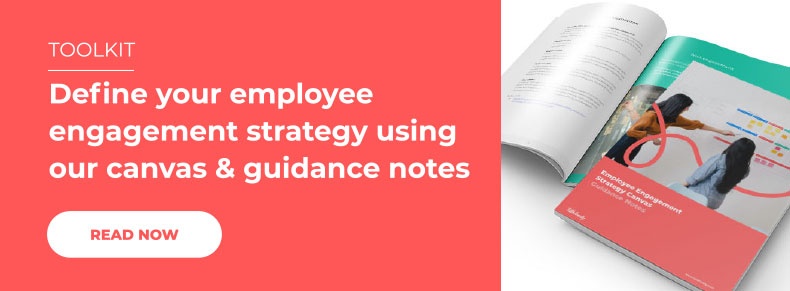In just one year, everything has changed. The events of 2020 have had a phenomenal impact on today’s workplace. From remote working to job losses and uncertain futures, everyone has felt the force of the pandemic.
And how has this affected employee engagement? It’s clear that internal communications departments are going to see dramatic changes in the wake of all this turmoil. Employee engagement practices have been thrown into the spotlight. This has highlighted any failings, along with the successes. Businesses are now being forced to reassess how they can best communicate with their dispersed workforce. And that means new ways of working.
We’re taking a look at the latest employee engagement trends that have emerged in the wake of the worldwide crisis. The good news is that these trends are universally positive. They are all working hard to improve employee engagement in the face of extremely challenging circumstances. It seems that companies have taken a good hard look at their current practices and taken steps to rectify errors and improve results.
Trend #1: Internal communications goes digital
It’s fair to say that traditional internal communication methods were already feeling outdated. Printed newsletters, company-wide emails, and town hall meetings were no longer achieving the desired impact. But the events of 2020 certainly fast-forwarded their demise.
Digital channels have quickly become the standard. With so many employees transferred to remote working, companies need to communicate instantly and effectively, reaching every worker, no matter where they are based. Employee engagement software has now taken its place as the prime solution. The rapid implementation of these platforms is one of the key trends in employee engagement.
There are many reasons why employee apps have taken pole position. Their impressive reach is one of the key factors. How to connect non-desk workers has been a constant discussion and this is where apps excel. By opening up communication channels, they have been breaking down the barriers to employee engagement that have proved most troublesome to overcome.
Their immediacy has also proved highly practical in the current working climate. Internal communications departments have found an increased demand for time-specific, often instantaneous messaging. Instant notifications have become a must-have specification of any employee engagement solution.
The switch to digital has also been necessary to create a sense of belonging amongst a dispersed and isolated workforce. By offering employee social spaces in which to meet, chat and share, the employee engagement app helps to restore the workplace culture that has been missing for so long.
Trend #2: Employee communication is personalised
The one-size-fits-all approach just doesn’t cut it in 2021. Now, more than ever, your employee engagement model has to be flexible and adaptable. Businesses have realised that it’s necessary to take a range of approaches to reach their workforce, and they need to ensure that their messaging really resonates when it connects.
Internal communications departments are taking a leaf out of Marketing’s book and considering their audiences first. By leading with their audiences, working with what’s important to them and how they engage, they are finally engaging in a way that really works.
Rather than broadcasting messages to the general workforce, they are creating personalised content, produced with audiences in mind.
This personalised approach doesn’t just stop at the content of the messaging. Employee engagement initiatives are now considering internal communication channels as well. They are giving employees a choice. Employee engagement software allows you to personalise your approach by offering communication channels to match individual preferences – another reason for its successful uptake. This new trend has been extremely well-received by all workers, remote or office-based.
Trend #3: Employee wellbeing takes the spotlight
Health and wellbeing was already a focal point in 2020, but now it’s become a prime concern.
As well as the coronavirus itself affecting employees and their families, there are also significant mental health consequences to be aware of. The mental health charity Mind that more than half of adults (60%) and over two-thirds of young people (68%) said their mental health got worse during lockdown. Isolation, stress and anxiety are all issues that need to be addressed by the responsible employer.
Employers are also reaching out to ensure that remote employees are operating from safe workplaces. This requires more targeted messaging to avoid injury and any resulting insurance claims.
However, these new employee engagement initiatives are not just about avoiding a costly insurance bill. We’re also seeing the caring side of communication springing up, with employers connecting on a more emotional level. More pulse surveys are being sent out, more feedback is being collected and listened to, as organisations wake up to the tangible benefits of taking employee wellbeing more seriously.
Trend #4: Leaders take a more empathetic approach
Building on from the last point, this is one of the most encouraging new trends in employee engagement. We’re finally seeing leaders starting to speak less to the heads and more to the hearts.
Throughout 2020, we saw leadership communication evolve from the traditional formal, corporate tone to a more authentic and empathetic approach. This welcome change has had an amazing impact on employee engagement and motivation. Any message that engages the heart will have a far greater effect on eventual outcomes.
It’s not just the emotional tone of the communications that have evolved. Leaders have been pressurised to simplify their messaging and adopt a more authentic style of communicating. While it has been vital to ensure important information reaches employees, it’s just as crucial to ensure that a sense of company values and community spirit is conveyed at the same time.
This authentic approach has been shown to be one of the key drivers of employee engagement.
Trend #5: Employee feedback becomes indispensable
Yes, leaders have always listened to their employees. But until now, rarely has employee feedback been given such a high priority. It’s one of the trends in global employee engagement that is really transforming the workplace.
With a remote workforce, it is harder than ever to assess the mood and motivation levels of employees. In 2021, the employee engagement survey has become a vital tool that’s top of everyone’s to-do list.
The need for the employee voice to be heard has never been more acute. Internal communication departments are firing out questionnaires on a regular basis. And, crucially, they’re acting on the feedback. This is where the employee app has really come into play, scheduling regular pulse surveys and polls and tracking the responses automatically.
The fact is, employees are going to speak out whether you listen to them or not. Gartner predicts that by 2022, one-third of crisis communication budgets will be used to respond to employees speaking out against their organisations. It’s clear that increasing listening skills, and acting quickly on your findings, is going to be a crucial element of any strategy for 2021.
A positive outlook
The events of the last year have made a significant impact on our working lives. And it’s fair to say that this impact has been largely negative. However, it is encouraging to see that the spotlight placed on internal communications has proved to be beneficial. These emerging employee engagement trends are lights in the darkness and will hopefully lead us forward to a brighter future.
Topics:
Employee Engagement







.jpg)
.jpg)